Extra credit opportunity
Okay, class. Since a couple people were paying attention, and noticed that bone pile of old statues behind the museum, I've decided to.... Would you please pay attention? I'm getting tired of having to separate you two! Where was I? Oh, yes.
So, some people asked about those old statues, so here's the background.
Way back when, when as Tom Lehrer put it ...Germans were warlike and mean*, down in that big park in the middle of Berlin called the Tiergarten was a place known as the Siegesallee. You could roughly translate that as Victory Avenue.
Anyway, back on 27 January 1895, the 36th birthday of Wilhelm II, the guy who later brought us WWI, decided to commission a whole bunch of statues, and then line the Siegesallee with all the great rulers of German history. Since a whole bunch of German history was about wars (sad, but true) most of the statues were Kaisers and other war-time leaders. So, the place was created, and ran for 750 meters through the forest of the Kaiser's private hunting preserve. It had two broad, parallel walkways down the center, and statue groupings on both sides.
Here's a picture of what the place looked like. That tall thing at the end is the Siegessäule or Victory Column, which celebrates the defeat of Napoleon, that short French guy. It's made of french cannons. No, I'm not kidding about that.
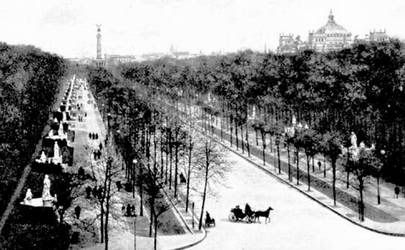
The statues were placed in groups, that usually included a specific ruler and then smaller statues of his chief henchmen associates. Here are some pictures of typical groups.
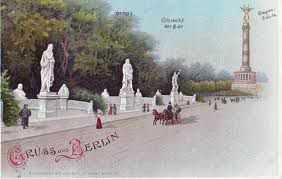
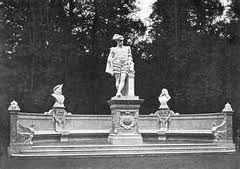
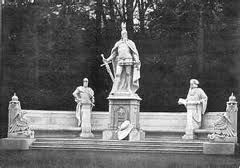
There were more than 100 in total, and people were encouraged to come walk along and relive those great moments in history. Most groups included benches where you could sit down and hang out with your personal favorites. The actual list of heroes was impressive, but, given the times, the Kaiser chose to omit a few that weren't on his personal Top Ten list. Even in those days, the locals were editing history, and probably served as role models for Hitler and Stalin.
In any case, the place was a pretty nice hangout during the summer.
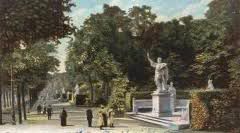
However, Berliners weren't impressed. The statues were hardly great works of art, and they soon began to call the place by less attractive names. For many it became the Puppenallee, which meant Avenue of the Dolls. Berliners had, and still have, a truly unique sense of humor. When things were darkest in the spring of 1945, someone wrote on a wall (Germans are great with graffiti, even today) Enjoy the war. The peace is going to be worse. The sad part of that is that the author was absolutely correct.
Anyway, at the end of World War II, changes were made. First, the place had been hit by numerous bombs, so there was a bunch of damage here and there. Also, the allies decided that it would be best to eliminate any obvious record of the nasty German militarism that had caused such problems, so they mandated that the whole place go away.
Now, big stone statues aren't the easiest thing to get rid of, and the allies didn't seem to want to devote the effort to crush them to little bits of rock. Honestly they were too busy trying to dismantle the three Flakturm, and finally gave up on two of them. Say what you want, Speer built them really tough, and only the British succeeded in blasting apart the one in the zoo, just north of this place.
So...the next best thing was to make these guys, and pieces of guys, just disappear somewhere. So, they were loaded into trucks, hauled to a hole and buried. So, for a second time they didn't get any respect. This whole affair is what created Rodney Dangerfield!
Now, later on, in 1979 to be exact, they were "rediscovered" hanging out in their hole, exhumed, and now really got respect. They were moved to some space at Berlin’s first sewage pumping station, which had since its closure in 1972 been an ad hoc museum. Hey, I'm not making this stuff up. I'm a writer by trade, but even I couldn't dream up this plot.
Now, a few years later, in 2006 to be exact, the "sort of" museum was closed, and the land sold to be turned into a restaurant. I was there a few weeks ago, and there still is no restaurant, just the remains of the Anhalter Bahnhof (once the biggest and busiest trains station in Europe) and a place called the Tempodrome. Oh well.
Moving along now.
So, the remaining statues were moved again, this time to the Zitadelle. There is a plan to display them in association with the museum on the grounds, and that's supposed to happen sometime in 2012, so we'll need to return in a year to see what's happened. In the meantime, here's the view along the Siegesallee today. The pathway is still there, but not as wide, and the alcoves for the statues have been reclaimed by the vegetation.
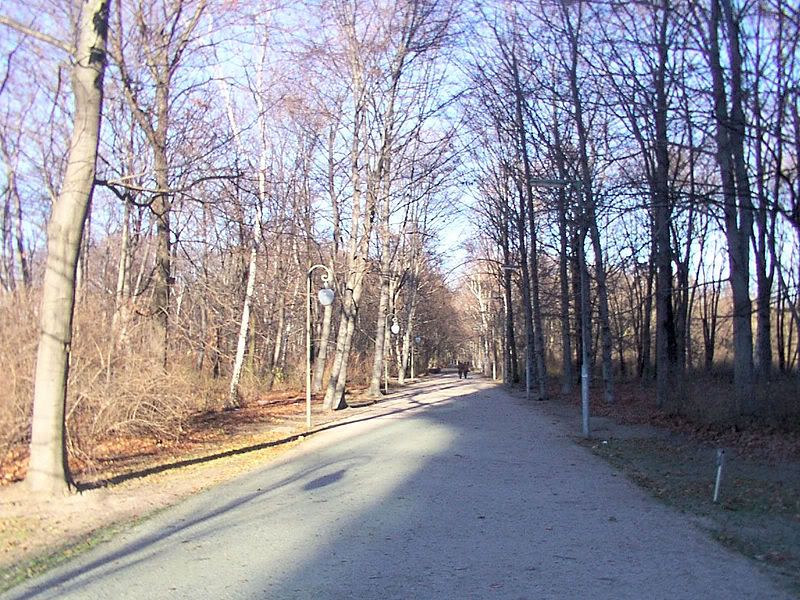
And, lastly, here are some pictures of the statues in storage.
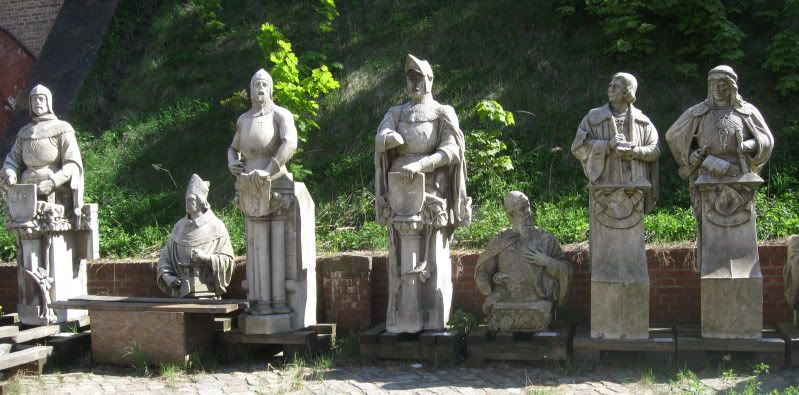
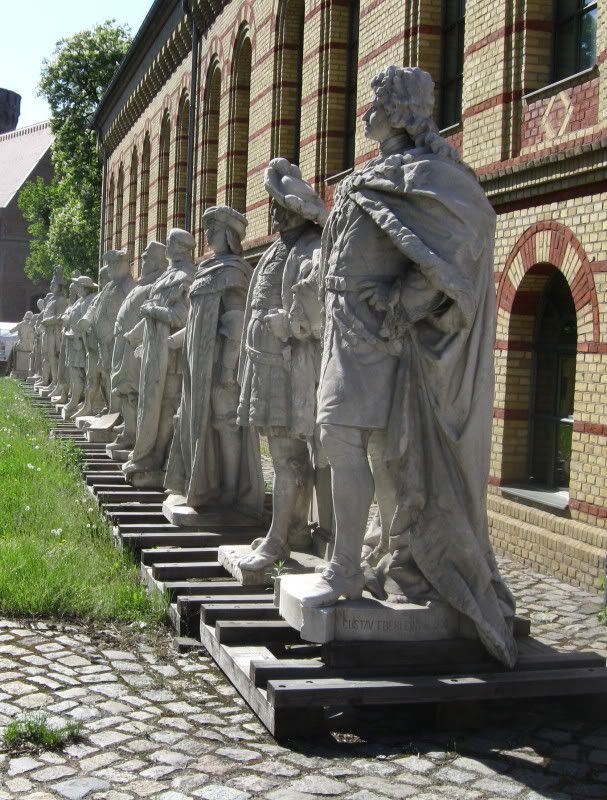
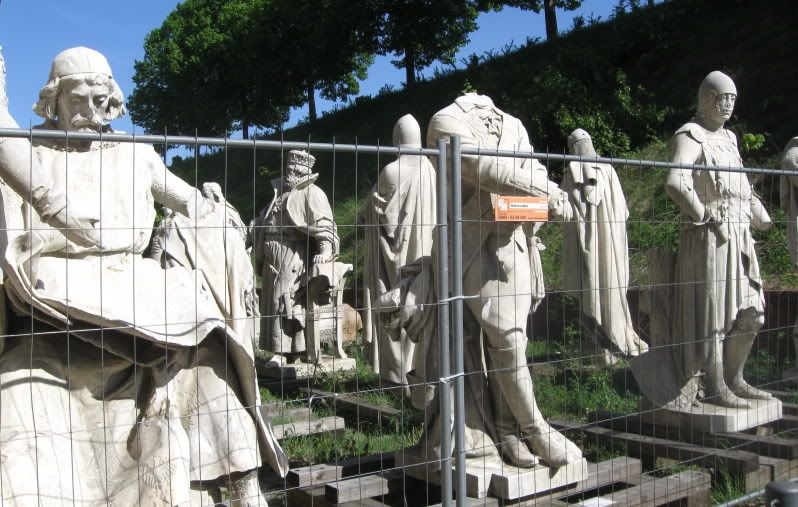
And, it's evident that not all of these guys are really happy about the treatment they've received over the years. Honestly, can't say as I blame them. It's been a rough life, even for a piece of rock.
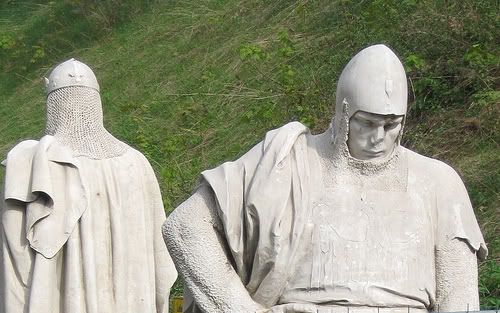
So, that's the story of the Siegesallee.
* For extra credit, you can post a response that explains the reference to Tom Lehrer. To get credit you will need to include the original title from which those words come.
C
So, some people asked about those old statues, so here's the background.
Way back when, when as Tom Lehrer put it ...Germans were warlike and mean*, down in that big park in the middle of Berlin called the Tiergarten was a place known as the Siegesallee. You could roughly translate that as Victory Avenue.
Anyway, back on 27 January 1895, the 36th birthday of Wilhelm II, the guy who later brought us WWI, decided to commission a whole bunch of statues, and then line the Siegesallee with all the great rulers of German history. Since a whole bunch of German history was about wars (sad, but true) most of the statues were Kaisers and other war-time leaders. So, the place was created, and ran for 750 meters through the forest of the Kaiser's private hunting preserve. It had two broad, parallel walkways down the center, and statue groupings on both sides.
Here's a picture of what the place looked like. That tall thing at the end is the Siegessäule or Victory Column, which celebrates the defeat of Napoleon, that short French guy. It's made of french cannons. No, I'm not kidding about that.

The statues were placed in groups, that usually included a specific ruler and then smaller statues of his chief henchmen associates. Here are some pictures of typical groups.



There were more than 100 in total, and people were encouraged to come walk along and relive those great moments in history. Most groups included benches where you could sit down and hang out with your personal favorites. The actual list of heroes was impressive, but, given the times, the Kaiser chose to omit a few that weren't on his personal Top Ten list. Even in those days, the locals were editing history, and probably served as role models for Hitler and Stalin.
In any case, the place was a pretty nice hangout during the summer.

However, Berliners weren't impressed. The statues were hardly great works of art, and they soon began to call the place by less attractive names. For many it became the Puppenallee, which meant Avenue of the Dolls. Berliners had, and still have, a truly unique sense of humor. When things were darkest in the spring of 1945, someone wrote on a wall (Germans are great with graffiti, even today) Enjoy the war. The peace is going to be worse. The sad part of that is that the author was absolutely correct.
Anyway, at the end of World War II, changes were made. First, the place had been hit by numerous bombs, so there was a bunch of damage here and there. Also, the allies decided that it would be best to eliminate any obvious record of the nasty German militarism that had caused such problems, so they mandated that the whole place go away.
Now, big stone statues aren't the easiest thing to get rid of, and the allies didn't seem to want to devote the effort to crush them to little bits of rock. Honestly they were too busy trying to dismantle the three Flakturm, and finally gave up on two of them. Say what you want, Speer built them really tough, and only the British succeeded in blasting apart the one in the zoo, just north of this place.
So...the next best thing was to make these guys, and pieces of guys, just disappear somewhere. So, they were loaded into trucks, hauled to a hole and buried. So, for a second time they didn't get any respect. This whole affair is what created Rodney Dangerfield!
Now, later on, in 1979 to be exact, they were "rediscovered" hanging out in their hole, exhumed, and now really got respect. They were moved to some space at Berlin’s first sewage pumping station, which had since its closure in 1972 been an ad hoc museum. Hey, I'm not making this stuff up. I'm a writer by trade, but even I couldn't dream up this plot.
Now, a few years later, in 2006 to be exact, the "sort of" museum was closed, and the land sold to be turned into a restaurant. I was there a few weeks ago, and there still is no restaurant, just the remains of the Anhalter Bahnhof (once the biggest and busiest trains station in Europe) and a place called the Tempodrome. Oh well.
Moving along now.
So, the remaining statues were moved again, this time to the Zitadelle. There is a plan to display them in association with the museum on the grounds, and that's supposed to happen sometime in 2012, so we'll need to return in a year to see what's happened. In the meantime, here's the view along the Siegesallee today. The pathway is still there, but not as wide, and the alcoves for the statues have been reclaimed by the vegetation.

And, lastly, here are some pictures of the statues in storage.



And, it's evident that not all of these guys are really happy about the treatment they've received over the years. Honestly, can't say as I blame them. It's been a rough life, even for a piece of rock.

So, that's the story of the Siegesallee.
* For extra credit, you can post a response that explains the reference to Tom Lehrer. To get credit you will need to include the original title from which those words come.
C